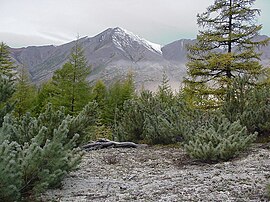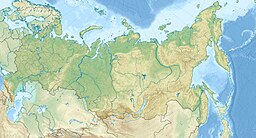Kolyma Mountains References Navigation menu63°N 159°E / 63°N 159°E / 63; 15963°N 159°E / 63°N 159°E / 63; 159"Kolyma Upland""Колымское нагорье"expanding ite

Multi tool use
Mountain ranges of RussiaLandforms of Magadan OblastRussian Far East geography stubs
RussianSiberiaMagadan OblastSea of OkhotskKolymagranite
Kolyma Mountains
Jump to navigation
Jump to search
| Kolyma Mountains | |
|---|---|
 | |
| Highest point | |
| Peak | Omsukchan Ridge |
| Elevation | 1,962 m (6,437 ft) |
| Dimensions | |
| Length | 1,300 km (810 mi) |
| Geography | |
 | |
| Country | Russia |
| Oblast/Krai | Magadan Oblast |
| Range coordinates | 63°N 159°E / 63°N 159°E / 63; 159Coordinates: 63°N 159°E / 63°N 159°E / 63; 159 |
| Geology | |
| Age of rock | Jurassic, Triassic, Permian and Proterozoic |
| Type of rock | Granite, Gneiss, Schist, Siltstone, Sandstone |
The Kolyma Mountains or Kolyma Upland (Russian: Колымское нагорье, tr. Kolymskoye Nagorye) is a mountain range in northeastern Siberia, lying mostly within the Magadan Oblast, along the shores of the Sea of Okhotsk in the Kolyma region.[1] It stretches 1,300 kilometers (810 mi) on a NW-SW alignment and consists of a series of plateaus and ridges punctuated by granite peaks that typically range between 1,500 to 1,800 meters (4,900 to 5,900 ft). The range's highest point is the Omsukchan Ridge at 1,962 meters (6,437 ft).[2]
References
^ "Kolyma Upland". Encyclopædia Britannica. July 20, 1998..mw-parser-output cite.citationfont-style:inherit.mw-parser-output .citation qquotes:"""""""'""'".mw-parser-output .citation .cs1-lock-free abackground:url("//upload.wikimedia.org/wikipedia/commons/thumb/6/65/Lock-green.svg/9px-Lock-green.svg.png")no-repeat;background-position:right .1em center.mw-parser-output .citation .cs1-lock-limited a,.mw-parser-output .citation .cs1-lock-registration abackground:url("//upload.wikimedia.org/wikipedia/commons/thumb/d/d6/Lock-gray-alt-2.svg/9px-Lock-gray-alt-2.svg.png")no-repeat;background-position:right .1em center.mw-parser-output .citation .cs1-lock-subscription abackground:url("//upload.wikimedia.org/wikipedia/commons/thumb/a/aa/Lock-red-alt-2.svg/9px-Lock-red-alt-2.svg.png")no-repeat;background-position:right .1em center.mw-parser-output .cs1-subscription,.mw-parser-output .cs1-registrationcolor:#555.mw-parser-output .cs1-subscription span,.mw-parser-output .cs1-registration spanborder-bottom:1px dotted;cursor:help.mw-parser-output .cs1-ws-icon abackground:url("//upload.wikimedia.org/wikipedia/commons/thumb/4/4c/Wikisource-logo.svg/12px-Wikisource-logo.svg.png")no-repeat;background-position:right .1em center.mw-parser-output code.cs1-codecolor:inherit;background:inherit;border:inherit;padding:inherit.mw-parser-output .cs1-hidden-errordisplay:none;font-size:100%.mw-parser-output .cs1-visible-errorfont-size:100%.mw-parser-output .cs1-maintdisplay:none;color:#33aa33;margin-left:0.3em.mw-parser-output .cs1-subscription,.mw-parser-output .cs1-registration,.mw-parser-output .cs1-formatfont-size:95%.mw-parser-output .cs1-kern-left,.mw-parser-output .cs1-kern-wl-leftpadding-left:0.2em.mw-parser-output .cs1-kern-right,.mw-parser-output .cs1-kern-wl-rightpadding-right:0.2em
^ "Колымское нагорье" [Kolyma Highlands]. Great Soviet Encyclopedia (in Russian) (3rd ed.). 1969–1978.
This Russian Far East location article is a stub. You can help Wikipedia by expanding it. |
Categories:
- Mountain ranges of Russia
- Landforms of Magadan Oblast
- Russian Far East geography stubs
(RLQ=window.RLQ||[]).push(function()mw.config.set("wgPageParseReport":"limitreport":"cputime":"0.516","walltime":"0.669","ppvisitednodes":"value":1838,"limit":1000000,"ppgeneratednodes":"value":0,"limit":1500000,"postexpandincludesize":"value":35771,"limit":2097152,"templateargumentsize":"value":7995,"limit":2097152,"expansiondepth":"value":16,"limit":40,"expensivefunctioncount":"value":1,"limit":500,"unstrip-depth":"value":1,"limit":20,"unstrip-size":"value":5601,"limit":5000000,"entityaccesscount":"value":1,"limit":400,"timingprofile":["100.00% 635.101 1 -total"," 45.99% 292.090 1 Template:Infobox_mountain_range"," 40.65% 258.142 1 Template:Infobox"," 32.20% 204.471 1 Template:Lang-rus"," 31.31% 198.847 1 Template:Language_with_name"," 30.79% 195.555 2 Template:Lang"," 17.93% 113.866 1 Template:Reflist"," 16.52% 104.917 2 Template:Cite_encyclopedia"," 14.33% 90.993 7 Template:Convert"," 8.78% 55.732 2 Template:Convinfobox"],"scribunto":"limitreport-timeusage":"value":"0.356","limit":"10.000","limitreport-memusage":"value":13077250,"limit":52428800,"cachereport":"origin":"mw1330","timestamp":"20190713171345","ttl":2592000,"transientcontent":false););"@context":"https://schema.org","@type":"Article","name":"Kolyma Mountains","url":"https://en.wikipedia.org/wiki/Kolyma_Mountains","sameAs":"http://www.wikidata.org/entity/Q1245603","mainEntity":"http://www.wikidata.org/entity/Q1245603","author":"@type":"Organization","name":"Contributors to Wikimedia projects","publisher":"@type":"Organization","name":"Wikimedia Foundation, Inc.","logo":"@type":"ImageObject","url":"https://www.wikimedia.org/static/images/wmf-hor-googpub.png","datePublished":"2016-12-13T02:40:20Z","dateModified":"2019-02-05T13:37:31Z","image":"https://upload.wikimedia.org/wikipedia/commons/e/ed/Kolyma_Nature.jpg","headline":"mountain range"(RLQ=window.RLQ||[]).push(function()mw.config.set("wgBackendResponseTime":94,"wgHostname":"mw1266"););wAh4QB2HqU6jH,RzHPQ2gIA dYuF 2 Ouc7,N,VU2